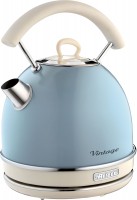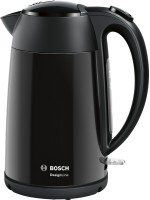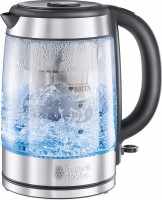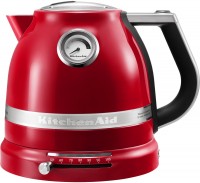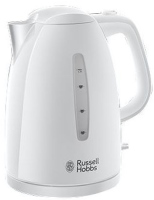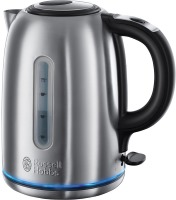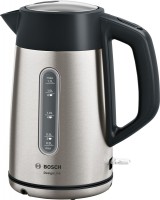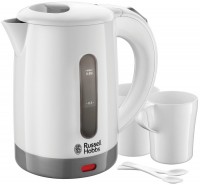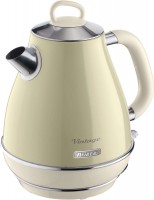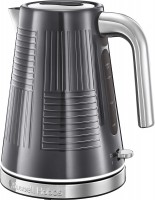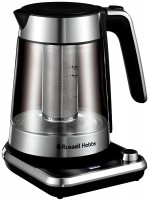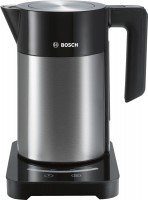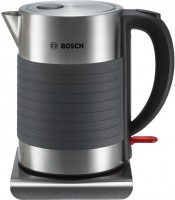Electric Kettles Tefal
All Electric Kettles Advanced filters → |
You might be interested in
Articles, reviews, useful tips
All materials
The best electric kettles in retro design
Beautiful electric kettles with an antique design that will become the highlight of the kitchen

Guide to key Xiaomi sub-brands
The Chinese corporation Xiaomi operates over two hundred subsidiaries.
Electric Kettles: specifications, types
Type
— Electric kettle.Electric kettles are traditional water heating containers that come with built-in heaters. Unlike thermopots (which are designed to maintain the temperature of the liquid), electric kettles are primarily intended for boiling water and do not have advanced temperature control features.
— Thermopot. Thermopots are hybrid devices that incorporate features of both electric kettles and thermoses. They have thick walls, often double-layered, and a tighter lid, which provides improved thermal insulation compared to traditional electric kettles. Additionally, they typically have a built-in pump for dispensing water. The primary advantage of a thermopot is its ability to both heat water and maintain its temperature for an extended period, thanks to the enhanced insulation. This makes them ideal for situations where a constant supply of hot water is needed. However, they are slower to heat water compared to regular electric kettles, so it's essential to plan ahead.
— Hot water dispenser. A kind of kettles, outwardly similar to thermo pots, but according to the principle of operation, it resembles the “hot water” function in coffee machines. The dispenser is designed to store water and does not have a built-in heater. Instead, the heating process occurs when water is dispensed, resulting in hot water being availabl...e within seconds. This process is energy-efficient since only the volume of water dispensed is heated. Dispensers usually offer a range of temperature controls, and some models allow for a predetermined amount of hot water to be dispensed. However, the main drawback of these devices is their relatively high cost.
— Brewing.These are kettles that are specifically designed for brewing tea and other beverages. They feature a strainer or a similar device for steeping tea leaves or herbs. Many of these models come equipped with a thermostat, which makes it easy to select the ideal brewing temperature for different types of tea. Glass is the preferred material for the body of such kettles, often in combination with metal, as it allows for monitoring the brewing process, controlling the colour and transparency of the contents, while not affecting the taste or aroma of the beverage. These kettles can also be used to heat water for other purposes, by simply removing the strainer or leaving it empty.
— Brewing kit. A hot drink preparation kit that includes two separate vessels, a kettle and a teapot. The kettle is used to heat water, while the teapot may not have a built-in heater and can be a traditional vessel. This option may be more suitable for certain types of tea that require immediate infusion with hot water. However, two-piece sets tend to be heavier, larger, and more costly than multipurpose kettles with brewing capabilities, which makes them less popular nowadays.
It's worth mentioning that samovars in the form of electric kettles are also considered brewing kits, but they have unique features that distinguish them from other types and warrant their classification as a separate category (see below).
— For brewing coffee. Kettles with an elegant "swan neck" design feature a thin, curved S-shaped spout that allows for precise pouring of water. Some models for making coffee also have the ability to control the water temperature accurately. This allows for a gradual and even supply of hot water through the spout, resulting in a well-extracted coffee during the brewing process. These kettles are also suitable for making certain types of tea that require precise temperature control during preparation.
— Samovar. Electric samovars are modern devices designed to imitate traditional samovars. These models usually have a retro design (see "Design"), but there are also original-looking devices within this style. Typically, an electric samovar consists of a main vessel for heating water and a teapot, which is placed on top of the main vessel and is heated by its heat. While electric samovars are functional, they are bulkier and more expensive than regular electric kettles. As a result, they are not commonly produced and are mainly aimed at enthusiasts of antique items and those who enjoy unique kitchen accessories.
— Thermopot. Thermopots are hybrid devices that incorporate features of both electric kettles and thermoses. They have thick walls, often double-layered, and a tighter lid, which provides improved thermal insulation compared to traditional electric kettles. Additionally, they typically have a built-in pump for dispensing water. The primary advantage of a thermopot is its ability to both heat water and maintain its temperature for an extended period, thanks to the enhanced insulation. This makes them ideal for situations where a constant supply of hot water is needed. However, they are slower to heat water compared to regular electric kettles, so it's essential to plan ahead.
— Hot water dispenser. A kind of kettles, outwardly similar to thermo pots, but according to the principle of operation, it resembles the “hot water” function in coffee machines. The dispenser is designed to store water and does not have a built-in heater. Instead, the heating process occurs when water is dispensed, resulting in hot water being availabl...e within seconds. This process is energy-efficient since only the volume of water dispensed is heated. Dispensers usually offer a range of temperature controls, and some models allow for a predetermined amount of hot water to be dispensed. However, the main drawback of these devices is their relatively high cost.
— Brewing.These are kettles that are specifically designed for brewing tea and other beverages. They feature a strainer or a similar device for steeping tea leaves or herbs. Many of these models come equipped with a thermostat, which makes it easy to select the ideal brewing temperature for different types of tea. Glass is the preferred material for the body of such kettles, often in combination with metal, as it allows for monitoring the brewing process, controlling the colour and transparency of the contents, while not affecting the taste or aroma of the beverage. These kettles can also be used to heat water for other purposes, by simply removing the strainer or leaving it empty.
— Brewing kit. A hot drink preparation kit that includes two separate vessels, a kettle and a teapot. The kettle is used to heat water, while the teapot may not have a built-in heater and can be a traditional vessel. This option may be more suitable for certain types of tea that require immediate infusion with hot water. However, two-piece sets tend to be heavier, larger, and more costly than multipurpose kettles with brewing capabilities, which makes them less popular nowadays.
It's worth mentioning that samovars in the form of electric kettles are also considered brewing kits, but they have unique features that distinguish them from other types and warrant their classification as a separate category (see below).
— For brewing coffee. Kettles with an elegant "swan neck" design feature a thin, curved S-shaped spout that allows for precise pouring of water. Some models for making coffee also have the ability to control the water temperature accurately. This allows for a gradual and even supply of hot water through the spout, resulting in a well-extracted coffee during the brewing process. These kettles are also suitable for making certain types of tea that require precise temperature control during preparation.
— Samovar. Electric samovars are modern devices designed to imitate traditional samovars. These models usually have a retro design (see "Design"), but there are also original-looking devices within this style. Typically, an electric samovar consists of a main vessel for heating water and a teapot, which is placed on top of the main vessel and is heated by its heat. While electric samovars are functional, they are bulkier and more expensive than regular electric kettles. As a result, they are not commonly produced and are mainly aimed at enthusiasts of antique items and those who enjoy unique kitchen accessories.
Design
The design in which the electric kettle is decorated. In addition to the classic design, nowadays there are more original styles, namely:
— Retro. Devices stylized antique — mainly for kitchen utensils of the 30s — 50s of the XX century. The degree of stylization in this case can be different: for example, some appliances are not different from ordinary kitchen kettles that are placed on the stove. Also note that almost all samovars are performed in retro style (see "Type"). But thermopots and teapots in this design are almost never produced. Anyway, a retro kettle will be indispensable for a kitchen in the same style, but it can also fit into a modern interior.
— Hi-tech. The devices that have a technological, sometimes even futuristic design — using unpainted metal, transparent glass, as well as a minimal amount (or even complete absence) of decorative details. At the same time, the design can be quite unusual: for example, there are models that taper upward and vaguely resemble laboratory flasks. Like the retro style, almost no other devices are produced in this style other than classic kettles.
When choosing a device in a specific design, note that the design inevitably affects the cost — sometimes quite noticeably, despite the fact that it usually does not provide functional advantages.
— Retro. Devices stylized antique — mainly for kitchen utensils of the 30s — 50s of the XX century. The degree of stylization in this case can be different: for example, some appliances are not different from ordinary kitchen kettles that are placed on the stove. Also note that almost all samovars are performed in retro style (see "Type"). But thermopots and teapots in this design are almost never produced. Anyway, a retro kettle will be indispensable for a kitchen in the same style, but it can also fit into a modern interior.
— Hi-tech. The devices that have a technological, sometimes even futuristic design — using unpainted metal, transparent glass, as well as a minimal amount (or even complete absence) of decorative details. At the same time, the design can be quite unusual: for example, there are models that taper upward and vaguely resemble laboratory flasks. Like the retro style, almost no other devices are produced in this style other than classic kettles.
When choosing a device in a specific design, note that the design inevitably affects the cost — sometimes quite noticeably, despite the fact that it usually does not provide functional advantages.
Volume
The nominal capacity of a kettle refers to the maximum amount of water that can be safely poured into it, and it is typically indicated by the water level indicator. In the case of brewing sets (see "Type"), the nominal capacity refers to the main kettle, while the capacity of the teapot is listed separately (see below).
The capacity of the electric kettle directly affects the amount of water that can be heated at once. A larger capacity allows for heating more water, but this also means the kettle will be larger and heavier. Additionally, heating a larger volume of water requires either more power or a longer time. Therefore, it is important to consider one's actual needs when choosing a kettle based on its capacity. For example, mini-kettles for travelling (or for one person) have a volume of up to 1 liter. For home use in a family of 2 – 3 people, a 1,5 – 2 liter model is enough. Devices for 2 – 3 liters are already well suited for a small office or a similar situation. The most spacious electric kettles are designed to hold 10 liters or more, and are typically used in public places such as canteens and cafes for dispensing hot water.
The capacity of the electric kettle directly affects the amount of water that can be heated at once. A larger capacity allows for heating more water, but this also means the kettle will be larger and heavier. Additionally, heating a larger volume of water requires either more power or a longer time. Therefore, it is important to consider one's actual needs when choosing a kettle based on its capacity. For example, mini-kettles for travelling (or for one person) have a volume of up to 1 liter. For home use in a family of 2 – 3 people, a 1,5 – 2 liter model is enough. Devices for 2 – 3 liters are already well suited for a small office or a similar situation. The most spacious electric kettles are designed to hold 10 liters or more, and are typically used in public places such as canteens and cafes for dispensing hot water.
Volume of teapot
The volume of the teapot supplied with the brewing set or samovar (see "Type").
A larger teapot allows you to make more drink at a time, but it turns out to be more bulky and expensive. Also note that this volume can be correlated differently with the capacity of the main kettle. So, in some models, the teapot is noticeably smaller than 2 — 4 times. This relation is especially convenient if the brewing is planned to be used several times, with minimal breaks between exposures (“sessions” of brewing): one kettle is enough for several exposures, and the time spent on each water heating is minimal. In other sets, the teapot does not differ or almost does not differ in volume from the main kettle — this option is convenient for drinks brewed once with a long exposure.
A larger teapot allows you to make more drink at a time, but it turns out to be more bulky and expensive. Also note that this volume can be correlated differently with the capacity of the main kettle. So, in some models, the teapot is noticeably smaller than 2 — 4 times. This relation is especially convenient if the brewing is planned to be used several times, with minimal breaks between exposures (“sessions” of brewing): one kettle is enough for several exposures, and the time spent on each water heating is minimal. In other sets, the teapot does not differ or almost does not differ in volume from the main kettle — this option is convenient for drinks brewed once with a long exposure.
Handle
The shape of the handle in the design of the electric kettle.
— Open. In an open form, the handle is not connected to the lower part of the body, creating a gap between the handle and the body. The handle is mounted only at the upper part of the body, leaving the other end free.
— Closed. Electric kettles with closed handles have their handles attached at both the top and bottom points to the body of the kettle, creating a loop for the user's hand to grip. The handle is directly connected to the body of the kettle, providing a secure grip while pouring.
— Open. In an open form, the handle is not connected to the lower part of the body, creating a gap between the handle and the body. The handle is mounted only at the upper part of the body, leaving the other end free.
— Closed. Electric kettles with closed handles have their handles attached at both the top and bottom points to the body of the kettle, creating a loop for the user's hand to grip. The handle is directly connected to the body of the kettle, providing a secure grip while pouring.
Power consumption
The power consumed by the kettle during operation is actually the power of the heating element installed in the device.
Two working moments depend on this parameter: heating intensity and electricity consumption. On the one hand, the high power of the heater allows you to quickly heat up a certain volume of water and saves time. On the other hand, the power consumption of such a device will also be appropriate. The wattage of a kettle's heater typically does not have a significant impact on electricity bills since the energy consumption required to heat a given volume of water remains the same regardless of the heater's power rating. However, there may be certain issues related to electrical connectivity. For example, if the wiring is weak or the fuses are improperly sized, the operation of a high-power heater may cause power outages. Additionally, devices with a power rating greater than 3500 W cannot be connected to a regular electrical outlet and require a specific power format. Consequently, even the largest thermal pots, which typically have a capacity of 10 L or more, are rarely equipped with heaters more powerful than 3000 W, since this power rating is sufficient for their intended use and can be connected to a standard electrical outlet.
Two working moments depend on this parameter: heating intensity and electricity consumption. On the one hand, the high power of the heater allows you to quickly heat up a certain volume of water and saves time. On the other hand, the power consumption of such a device will also be appropriate. The wattage of a kettle's heater typically does not have a significant impact on electricity bills since the energy consumption required to heat a given volume of water remains the same regardless of the heater's power rating. However, there may be certain issues related to electrical connectivity. For example, if the wiring is weak or the fuses are improperly sized, the operation of a high-power heater may cause power outages. Additionally, devices with a power rating greater than 3500 W cannot be connected to a regular electrical outlet and require a specific power format. Consequently, even the largest thermal pots, which typically have a capacity of 10 L or more, are rarely equipped with heaters more powerful than 3000 W, since this power rating is sufficient for their intended use and can be connected to a standard electrical outlet.
Power in the heating mode
The power consumed by the thermopot (see "Type") in the heating mode, when the device maintains the temperature of the previously heated water. Manufacturers select this power in such a way that the device is guaranteed to be able to maintain the claimed temperature. Therefore, the only point that should be assessed by this feature is the general “voracity” of the thermopot in terms of electricity consumption. However, this mode requires relatively little energy, and the heating power does not exceed 200 W in the most voluminous models.
Heating element
The type of heating element installed in the electric kettle.
— Spiral. The heating element of the kettle is a coiled tube located at the bottom of the kettle. This option is relatively inexpensive, but it requires that the spiral is always covered with water during use to prevent overheating and potential damage. Additionally, it can be challenging to manually clean the spiral from scale and other debris, although there are alternative cleaning methods available such as boiling water with certain products.
— Hidden. The hidden heating element is situated beneath the bottom of the kettle, meaning that the whole bottom functions as a heater. This design is regarded as more advanced compared to the open coil option. It is safe to operate with nearly any quantity of water, as long as the bottom is covered. Additionally, such heaters are significantly easier to clean. However, compared to open heaters, the hidden option is more expensive and produces more noise during use.
— Spiral. The heating element of the kettle is a coiled tube located at the bottom of the kettle. This option is relatively inexpensive, but it requires that the spiral is always covered with water during use to prevent overheating and potential damage. Additionally, it can be challenging to manually clean the spiral from scale and other debris, although there are alternative cleaning methods available such as boiling water with certain products.
— Hidden. The hidden heating element is situated beneath the bottom of the kettle, meaning that the whole bottom functions as a heater. This design is regarded as more advanced compared to the open coil option. It is safe to operate with nearly any quantity of water, as long as the bottom is covered. Additionally, such heaters are significantly easier to clean. However, compared to open heaters, the hidden option is more expensive and produces more noise during use.
Coating of the heating element
The outer covering of the heater is a significant factor in determining the characteristics of the kettle because it is in direct contact with the heated water. Therefore, the material used for this coating is an essential consideration in the kettle's properties.
— Stainless steel. "Stainless steel" is the most commonly used coating for kettles as it is affordable and provides good resistance to scale buildup. However, compared to more advanced materials, it may not offer the highest level of scale resistance.
— Aluminium. Another common material, slightly more expensive and resistant to scale than stainless steel, but in general not having significant differences.
— Ceramic. Ceramic coating is known for its exceptional resistance to both scale and corrosion. Although it cannot provide a complete guarantee against scale buildup, it does tend to form plaque at a much slower rate than on surfaces made of steel or aluminium. Additionally, many of these heaters can be cleaned with more aggressive descaling products that would not be suitable for metal coatings. However, due to their high cost, ceramic coatings are typically only used in premium kettles.
— Silver. Silver is another premium material that has good resistance to both scale and corrosion. In addition, it also possesses some antibacterial properties, making it a suitable choice for those who use the kettle to store cooled boiled water. However, the cost of silver pla...ting is quite high.
— Stainless steel. "Stainless steel" is the most commonly used coating for kettles as it is affordable and provides good resistance to scale buildup. However, compared to more advanced materials, it may not offer the highest level of scale resistance.
— Aluminium. Another common material, slightly more expensive and resistant to scale than stainless steel, but in general not having significant differences.
— Ceramic. Ceramic coating is known for its exceptional resistance to both scale and corrosion. Although it cannot provide a complete guarantee against scale buildup, it does tend to form plaque at a much slower rate than on surfaces made of steel or aluminium. Additionally, many of these heaters can be cleaned with more aggressive descaling products that would not be suitable for metal coatings. However, due to their high cost, ceramic coatings are typically only used in premium kettles.
— Silver. Silver is another premium material that has good resistance to both scale and corrosion. In addition, it also possesses some antibacterial properties, making it a suitable choice for those who use the kettle to store cooled boiled water. However, the cost of silver pla...ting is quite high.
Water level indicator
A device that allows you to estimate the amount of water in the kettle without opening its lid. Most often the water level indicator has the form of a scale applied either to the transparent wall of the container, or to a transparent insert in an opaque wall. In any case, this function allows you to measure the volume of filled water quite accurately, and not just determine it “by eye”. This possibility is especially important for models with open coils (see "Heating element"), in such devices, a mark on the indicator is usually applied to the minimum allowable water level.
Thermostat
A device that allows you to set the temperature to which the water will be heated — the thermostat monitors the temperature and automatically turns off the heating when the desired value is reached. In fact, water heated in a kettle does not always need to be boiled: for example, for brewing some types of tea, the optimum temperature is about 80 °C, and for preparing baby food — 60 °C. Thermopot are most often equipped with a thermostat, but there are also classic electric kettles with such a function.
Temperature adjustment
The temperature adjustment capabilities refer to the specific temperature values that can be programmed into the electric kettle. It's important to note that this refers to automatic adjustment, where the kettle turns off or switches to temperature maintenance mode once the desired temperature has been reached.
If this paragraph contains several options separated by commas (for example, “60 °С, 80 °С, 90 °С”), this means that this model has several fixed temperature options. However, there are also devices with smooth adjustment, which allows you to adjust the temperature in steps of 5 °C, or even 1 °C; for such devices, the entire adjustment range is indicated here, for example, "60 — 100 °C".
The greater the number of temperature setting options available in an electric kettle, the more versatile it becomes, allowing for precise selection of the optimal brewing mode for various types of drinks. Here is a simple table of recommended temperatures:
— white tea — 60 °C;
— yellow tea -70 °C;
— green tea — 80 °C;
— black tea — 90 °C;
— rooibos, hibiscus — 100 °C (up to boiling);
— baby food — 40 °C.
Of course, there are exceptions to such rules — depending on the specific type of drink. For example, some...varieties of green tea can be brewed at 90 °C.
If this paragraph contains several options separated by commas (for example, “60 °С, 80 °С, 90 °С”), this means that this model has several fixed temperature options. However, there are also devices with smooth adjustment, which allows you to adjust the temperature in steps of 5 °C, or even 1 °C; for such devices, the entire adjustment range is indicated here, for example, "60 — 100 °C".
The greater the number of temperature setting options available in an electric kettle, the more versatile it becomes, allowing for precise selection of the optimal brewing mode for various types of drinks. Here is a simple table of recommended temperatures:
— white tea — 60 °C;
— yellow tea -70 °C;
— green tea — 80 °C;
— black tea — 90 °C;
— rooibos, hibiscus — 100 °C (up to boiling);
— baby food — 40 °C.
Of course, there are exceptions to such rules — depending on the specific type of drink. For example, some...varieties of green tea can be brewed at 90 °C.
Maintaining t° (kettle)
The ability to operate a classic kettle (see "Type") in the mode of maintaining the water temperature — when the heated water is kept hot due to the operation of the heater at low power. For kettles, unlike thermopots, this mode is far from necessary, so its presence is indicated separately in the specs.
Thermometer
A device that displays the temperature of the water in the kettle. The presence of a thermometer is useful if the water needs to be heated to a certain temperature. However, the thermometer does not automatically turn off the kettle, unlike a thermostat — this must be done manually. Also, the thermometer allows you to assess how much the heated water has cooled over time and whether it can be used without heating again.
Delay start timer
A function that allows you to pre-set the start time of the kettle. For example, you can pour water in the evening and set a timer for the morning, so that by the time you woke up, it has just boiled. This eliminates the need to turn on the kettle manually and wait for the water to heat up.
Removable lid
The ability to completely remove the lid of the kettle. Such a possibility is not of particular importance during regular use, however, it provides additional convenience if the kettle needs to be washed from the inside — a removable lid, unlike a traditional non-removable one, will not hang on the fixture, hit your hands and create other discomforts. On the other hand, there is a certain risk of losing this lid, so this feature is not common.
Opening the lid with a button
Kettles (see "Type") in which the lid opens at the touch of a button. This opening is faster and more convenient, and often safer than the traditional way (grab the lid and pull it up): the lid can get quite hot when the kettle is in operation, and long contact with it is fraught with burns. And although the button can also be placed on the lid, a short press is enough to activate it, and even in such cases the risk of getting burned is minimal. On the other hand, opening the lid with a button complicates the design of the kettle and reduces its reliability.
Control via smartphone
The ability to remotely control the kettle from a smartphone, tablet or other similar gadget with a special application installed. The connection can be made via Wi-Fi or Bluetooth.
This feature does not only allow you to control the device from a distance, but often gives you more options than the classic control method. For example, special "chips" like a timer or thermostat can only be accessed through the application. In addition, the information about the operation of the kettle is transmitted to the application — for example, thermometer data, status (on/off), etc. Due to plenty of features, models controlled from a smartphone are often called “smart kettles”. Their main disadvantage is their high cost.
This feature does not only allow you to control the device from a distance, but often gives you more options than the classic control method. For example, special "chips" like a timer or thermostat can only be accessed through the application. In addition, the information about the operation of the kettle is transmitted to the application — for example, thermometer data, status (on/off), etc. Due to plenty of features, models controlled from a smartphone are often called “smart kettles”. Their main disadvantage is their high cost.
Water supply
— Water supply button. The electric pump button is used to control the built-in pump in the kettle, which is responsible for supplying water to the spout. It is considered to be the most advanced method of water supply as it requires no manual effort from the user, can work with any container, and allows for accurate measurement of the required volume. Some models even provide automatic dosing where the electric pump dispenses a strictly defined volume of liquid with just the touch of a button. However, these supply systems are more expensive and require a power supply, which can be a disadvantage for some users.
— Hand pump. The mechanical pump with a manual drive is integrated into the lid of the thermopot and is operated by a large button. This type of pump is simple, inexpensive, and does not require electricity to function, which is beneficial in case of power outages. However, it is not very convenient since multiple presses are required to fill even a small cup, and it is difficult to accurately measure the amount of water dispensed. As a result, it is typically used in conjunction with more advanced systems rather than being the sole method of dispensing water.
— Cup pressing. This method is also known as the "cup-activated dispensing system". It uses an electric pump, similar to the button systems described earlier, but the switch for the pump...is located near the spout and is activated by the cup's edge instead of by hand. This makes it easy to dispense water by simply bringing the cup to the spout and pressing the switch with the cup's edge. However, this method is not suitable for certain types of cups such as soft plastic or paper cups, and holding the cup while dispensing can be inconvenient as the hot water can burn one's hand through the walls of the cup. Therefore, this method is often combined with a traditional serving button to provide users with the most convenient option for their situation.
— Hand pump. The mechanical pump with a manual drive is integrated into the lid of the thermopot and is operated by a large button. This type of pump is simple, inexpensive, and does not require electricity to function, which is beneficial in case of power outages. However, it is not very convenient since multiple presses are required to fill even a small cup, and it is difficult to accurately measure the amount of water dispensed. As a result, it is typically used in conjunction with more advanced systems rather than being the sole method of dispensing water.
— Cup pressing. This method is also known as the "cup-activated dispensing system". It uses an electric pump, similar to the button systems described earlier, but the switch for the pump...is located near the spout and is activated by the cup's edge instead of by hand. This makes it easy to dispense water by simply bringing the cup to the spout and pressing the switch with the cup's edge. However, this method is not suitable for certain types of cups such as soft plastic or paper cups, and holding the cup while dispensing can be inconvenient as the hot water can burn one's hand through the walls of the cup. Therefore, this method is often combined with a traditional serving button to provide users with the most convenient option for their situation.
Blocking the water supply
A feature found mainly in thermopots and hot water dispensers. Recall that in such devices, water is supplied from a special spout at the touch of a button or lever (for more details, see "Water supply"). And blocking the water supply is useful primarily for families with small children — so that a curious baby does not get burned by turning on the water without adult supervision. The method of turning on and off the lock is selected in such a way as not to cause difficulties for an adult and at the same time be inaccessible to a child; a typical example is the simultaneous pressing of a pair of buttons on the control panel.
Body shape
The general shape of the body of the electric kettle.
— Conical. The most popular option: a body is wide at the base and tapering upwards. This form contributes to stability: the centre of gravity is maximally displaced downwards. However washing such a kettle from the inside may not be very convenient due to the relatively small size of the opening in the upper part.
— Cylindrical. The cylindrical shape provides more or less the same width of the body at the base and at the top. With the same height and base diameter, such kettles hold slightly more water than conical ones; in addition, such a device is easier to clean due to the wide opening for the lid.
— Inclined. The body which is inclined forward; the width of such a body is usually more or less the same over the entire height. Such kettles have an unusual, eye-catching appearance; in addition, it is easier to pour water from them — the device must be inclined at a smaller angle than with a cylindrical and even with a conical body. However, this option does not provide fundamental advantages over the same cylindrical shape, but it is more expensive, and therefore is not common.
— Conical. The most popular option: a body is wide at the base and tapering upwards. This form contributes to stability: the centre of gravity is maximally displaced downwards. However washing such a kettle from the inside may not be very convenient due to the relatively small size of the opening in the upper part.
— Cylindrical. The cylindrical shape provides more or less the same width of the body at the base and at the top. With the same height and base diameter, such kettles hold slightly more water than conical ones; in addition, such a device is easier to clean due to the wide opening for the lid.
— Inclined. The body which is inclined forward; the width of such a body is usually more or less the same over the entire height. Such kettles have an unusual, eye-catching appearance; in addition, it is easier to pour water from them — the device must be inclined at a smaller angle than with a cylindrical and even with a conical body. However, this option does not provide fundamental advantages over the same cylindrical shape, but it is more expensive, and therefore is not common.
Double-walled
Double-walled are found mainly among traditional electric kettles.
This design performs several functions at once. First of all, it significantly improves thermal insulation, allowing the kettle to retain heat longer and save energy when heating. Also, double-walled increase strength and reliability — it is more difficult to break through such a wall or noticeably damage it than a single one. And in some models, the outer side is made of plastic, and the inner side is made — of metal; this allows you to combine the advantages of both materials without a significant increase in cost.
This design performs several functions at once. First of all, it significantly improves thermal insulation, allowing the kettle to retain heat longer and save energy when heating. Also, double-walled increase strength and reliability — it is more difficult to break through such a wall or noticeably damage it than a single one. And in some models, the outer side is made of plastic, and the inner side is made — of metal; this allows you to combine the advantages of both materials without a significant increase in cost.
Display
The own display noticeably simplifies and facilitates the use of the kettle. Most often, this is the simplest single-colour screen, capable of displaying 2 — 3 figures and possibly the individual special symbols — however, in this case, more is not required. The display is especially convenient when selecting and controlling the heating temperature — after all, it is much more convenient to navigate by specific numbers than by simpler devices like colour indicators. Actually, the presence of a screen almost 100% guarantees that this model is also equipped with a thermostat.
Controller
The name of the controller installed in the device.
The controller is called an electronic circuit, which is directly responsible for managing the operation — primarily for turning off the heating when boiling or turning on without water. In our catalog, the name of such a circuit is specified if we are talking about an advanced controller that significantly exceeds most solutions on the market in terms of quality and reliability. At the same time, the specs indicate not a specific model, but a general brand — this is quite enough in this case.
The most reliable, durable and safe nowadays are the controllers of the British manufacturers Strix and Otter. There are no fundamental differences between these options in this regard, any of them is a sign of a quality kettle (even if the overall functionality of the device is rather modest). On the other hand, such equipment affects the price.
The controller is called an electronic circuit, which is directly responsible for managing the operation — primarily for turning off the heating when boiling or turning on without water. In our catalog, the name of such a circuit is specified if we are talking about an advanced controller that significantly exceeds most solutions on the market in terms of quality and reliability. At the same time, the specs indicate not a specific model, but a general brand — this is quite enough in this case.
The most reliable, durable and safe nowadays are the controllers of the British manufacturers Strix and Otter. There are no fundamental differences between these options in this regard, any of them is a sign of a quality kettle (even if the overall functionality of the device is rather modest). On the other hand, such equipment affects the price.
Backlight
Decorative lighting of the body or capacity of the kettle. It has mainly aesthetic value — it improves the appearance of the device. Sometimes it can serve as a kind of indicator, for example, change the colour when water is boiling.
Drip pan
A device found in thermopots and dispensers.
The drip pan in such devices is usually a depth under the spout for supplying water, covered with a grate; this grate acts as a cup holder. Thus, drops falling past the cup do not flow to the floor, but accumulate in the depth. The drip pan is released mainly due to the natural evaporation of water, in extreme cases it can be poured out or collected with a sponge.
The drip pan in such devices is usually a depth under the spout for supplying water, covered with a grate; this grate acts as a cup holder. Thus, drops falling past the cup do not flow to the floor, but accumulate in the depth. The drip pan is released mainly due to the natural evaporation of water, in extreme cases it can be poured out or collected with a sponge.
Material
The main material of the kettle.
Note that this paragraph primarily considers external material; the inner coating may differ from it. As for specific options, metal (usually steel), plastic and glass products are the most popular nowadays. More rare are glass with metal and ceramics (including porcelain). Here is a more detailed description of the different materials:
— Steel. Stainless steel is a popular material for kettles due to its strength, stylish appearance, and non-corrosive properties. It is available in a wide range of price categories. However, steel's high thermal conductivity may increase energy consumption and create a risk of burns. Steel is also opaque, so transparent inserts are necessary to monitor water levels. It is not suitable for teapots as it can give an extraneous aftertaste to the drink.
— Plastic. Plastic kettles are inexpensive and can be produced in various colors and transparency. They have low thermal conductivity, which reduces the risk of burns when touched. However, plastic is prone to scratches and can fade over time. Inexpensive plastic models may emit an unpleasant smell and taste when heated, but higher-priced models may use better quality plastic or have a metal lining to prevent this issue. Some high-end plastic materials are available b...ut cost more.
— Glass. Glass kettles have a visually appealing and transparent appearance, allowing you to easily monitor the water level without any special indicators. This is especially useful for teapots, as it enables the user to monitor the colour and saturation of the tea during the brewing process. Glass containers do not affect the taste or smell of the drink, which is highly beneficial for tea drinkers. Although glass is considered fragile, it is difficult to break such a container in reality. However, one of the downsides of glass containers is that any scale or contaminants inside the container are easily visible from the outside, requiring extra care to maintain their appearance. The thermal conductivity of glass is average, making it less prone to heat transfer than steel, but more so than many types of plastic. Therefore, touching a heated glass kettle should be avoided to prevent the risk of burns.
It should be noted that glass kettles often have parts made of materials other than glass. Usually, the top and bottom, as well as the handle, are made of plastic or a combination of plastic and metal. However, if these parts are mostly made of metal, the material is referred to as "glass with metal."
— Glass with metal. There are glass kettles that have metal top and bottom parts, with only a plastic insert in the lid for convenience purposes. These teapots are considered more advanced than the regular glass models that use plastic, as metal adds a sense of solidity and enhances durability. Also, since the contents of the kettle do not come into contact with plastic, the possibility of foreign tastes and odors is almost non-existent. However, such teapots are relatively expensive, although there are also affordable options available.
— Ceramics. Ceramics have a distinct advantage in terms of aesthetics as they offer a stylish appearance, making them an ideal choice for retro-style kettles or those with a classic design. Moreover, they are usually adorned with unique patterns and designs. Apart from their appearance, ceramic kettles do not affect the taste of the contents and provide excellent heat retention due to their thick walls. However, they are heavy and vulnerable to shocks, their opaque cases make it difficult to check water levels without opening the lid, and they lack water level indicators. Therefore, if appearance is a priority, ceramics can be an attractive option despite these drawbacks.
— Porcelain. Porcelain is a type of ceramic material that is highly valued for its prestigious appearance and is considered expensive. However, it is also fragile and requires delicate handling, which is why it is not commonly used in electric kettles.
Note that this paragraph primarily considers external material; the inner coating may differ from it. As for specific options, metal (usually steel), plastic and glass products are the most popular nowadays. More rare are glass with metal and ceramics (including porcelain). Here is a more detailed description of the different materials:
— Steel. Stainless steel is a popular material for kettles due to its strength, stylish appearance, and non-corrosive properties. It is available in a wide range of price categories. However, steel's high thermal conductivity may increase energy consumption and create a risk of burns. Steel is also opaque, so transparent inserts are necessary to monitor water levels. It is not suitable for teapots as it can give an extraneous aftertaste to the drink.
— Plastic. Plastic kettles are inexpensive and can be produced in various colors and transparency. They have low thermal conductivity, which reduces the risk of burns when touched. However, plastic is prone to scratches and can fade over time. Inexpensive plastic models may emit an unpleasant smell and taste when heated, but higher-priced models may use better quality plastic or have a metal lining to prevent this issue. Some high-end plastic materials are available b...ut cost more.
— Glass. Glass kettles have a visually appealing and transparent appearance, allowing you to easily monitor the water level without any special indicators. This is especially useful for teapots, as it enables the user to monitor the colour and saturation of the tea during the brewing process. Glass containers do not affect the taste or smell of the drink, which is highly beneficial for tea drinkers. Although glass is considered fragile, it is difficult to break such a container in reality. However, one of the downsides of glass containers is that any scale or contaminants inside the container are easily visible from the outside, requiring extra care to maintain their appearance. The thermal conductivity of glass is average, making it less prone to heat transfer than steel, but more so than many types of plastic. Therefore, touching a heated glass kettle should be avoided to prevent the risk of burns.
It should be noted that glass kettles often have parts made of materials other than glass. Usually, the top and bottom, as well as the handle, are made of plastic or a combination of plastic and metal. However, if these parts are mostly made of metal, the material is referred to as "glass with metal."
— Glass with metal. There are glass kettles that have metal top and bottom parts, with only a plastic insert in the lid for convenience purposes. These teapots are considered more advanced than the regular glass models that use plastic, as metal adds a sense of solidity and enhances durability. Also, since the contents of the kettle do not come into contact with plastic, the possibility of foreign tastes and odors is almost non-existent. However, such teapots are relatively expensive, although there are also affordable options available.
— Ceramics. Ceramics have a distinct advantage in terms of aesthetics as they offer a stylish appearance, making them an ideal choice for retro-style kettles or those with a classic design. Moreover, they are usually adorned with unique patterns and designs. Apart from their appearance, ceramic kettles do not affect the taste of the contents and provide excellent heat retention due to their thick walls. However, they are heavy and vulnerable to shocks, their opaque cases make it difficult to check water levels without opening the lid, and they lack water level indicators. Therefore, if appearance is a priority, ceramics can be an attractive option despite these drawbacks.
— Porcelain. Porcelain is a type of ceramic material that is highly valued for its prestigious appearance and is considered expensive. However, it is also fragile and requires delicate handling, which is why it is not commonly used in electric kettles.

